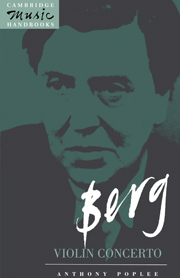1 - Musical ideologies: style and genre in the 1930s
Published online by Cambridge University Press: 05 June 2012
Summary
In 1932, just three years before the composition of Berg's Violin Concerto, one of the most famous of all concerto recordings under a composer's baton was made in London. The young Yehudi Menuhin, then a teenage virtuoso, was perhaps the first and probably the last great violinist to make his debut concerto recording with the work of a living composer. This was not the recent Violin Concerto by Stravinsky, however, nor the work of any other prominent composer of the age, but the concerto by Sir Edward Elgar – then in his seventy-fifth year and no longer seriously active in his profession. During his lifetime, Elgar had participated in the development of a thriving musical culture throughout Eastern and Western Europe, promoted by the growth of nationalism, but had more recently seen this culture all but destroyed in World War I. While the same nationalism was widely perceived as having sown the seeds of conflagration, the attention of nations was inevitably directed inwards during the period of rebuilding and reassessment which followed. The uncertainty thus engendered was to dictate changes in society which in turn affected musical life: the newly formed Soviet Union saw internal squabbles about the relation between progressive aesthetics and revolutionary politics; a xenophobic tendency latent in English musical nationalism now surfaced to the disadvantage of composers who maintained stylistic links with the European modernists.
- Type
- Chapter
- Information
- Berg: Violin Concerto , pp. 1 - 8Publisher: Cambridge University PressPrint publication year: 1991



